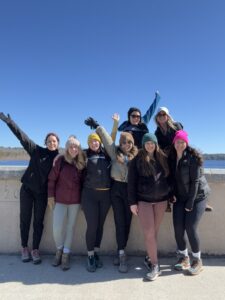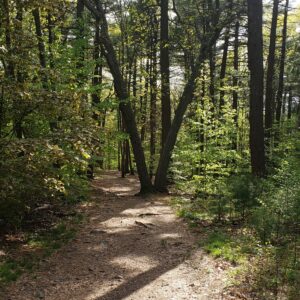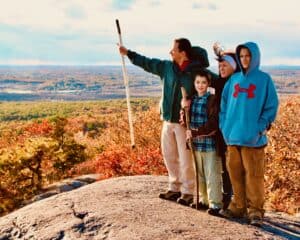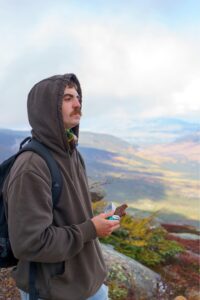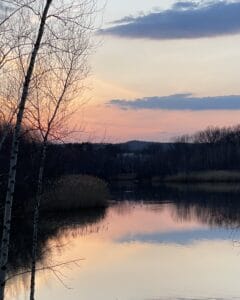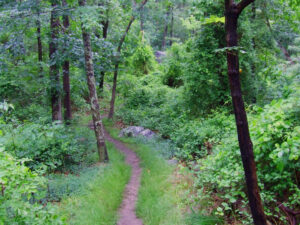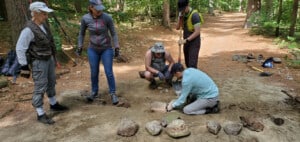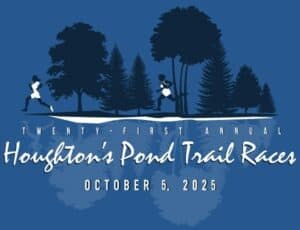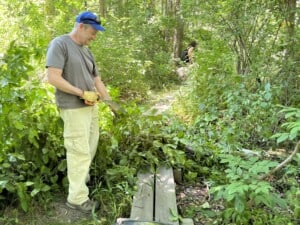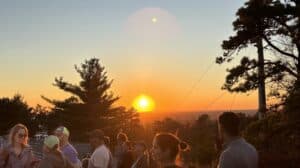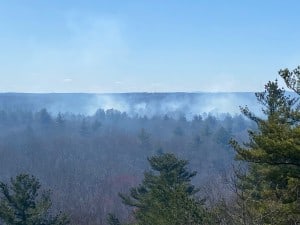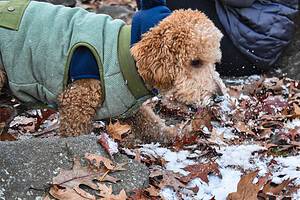The Blue Hills has lots of the invasive plant, garlic mustard – particularly at the AMC Ponkapoag cabins. Former Friends of the Blue Hills Board member, Robert Mussy, has had great success in controlling this invasive plant on his own property, which is very near the Blue Hills.
We’ve been pulling at the AMC cabins at Ponkapoag – so his success is inspirational!
It’s interesting that the deer eat it – which you would think would mean that the deer would help control garlic mustard. But because the “seed heads which pass through their digestive systems intact and fully viable,” they help the weed spread to new areas.
Many thanks to Robert Mussey for sharing the secret to his success!
My (Successful) Experiment Controlling Garlic Mustard
Robert Mussey, Milton, MA
Both public and private lands are under assault by relatively new invasive plants, some more noxious and aggressive than others. Among the worst offenders is garlic mustard, Alliaria petiolata. This herbaceous biennial plant can in a few short years entirely take over the forest floor or borders to become a 100% monoculture. It is among plants that are allelopathic, meaning once established, their roots emit chemicals which have the ability to inhibit or prevent the growth of native plants. It’s a very nasty trick.
The standard method of controlling or eradicating it is hand-pulling and bagging the green plants in black plastic bags before they go to seed, then allowing them to “cook” in the sun for at least a season. Many volunteer efforts to control it have lasted one or two years and as a result have been largely unsuccessful at eradication.
Reading a few articles on controlling it emboldened me to try my hand on a 50+ acre private property where some areas had become entirely infested. I had read the old saw, “One year’s seeding, seven years weeding”, meaning seeds that are broadcast by the plants this year can remain viable in the ground for seven years. So any effort at long term control would have to be sustained for at least seven years.
Now after 4 years of persistent pulling and patrolling, and an annual set of sore back and hand muscles, I can report near total success over the entire 50 acres. Here’s what I learned.
It is introduced to new areas and broadcast principally by deer — they love the stuff! I noticed initially that the infestations appeared to be in areas along clear deer trails, or in areas where they yard up during fawning season, or near watering spots. I also noticed new clumps in the woods often appear apparently from nowhere. Then Aha! I found these new clumps often have degraded deer droppings associated with them. I also found that in clumps of garlic mustard, I frequently found the plants grazed off neatly about 6″ from the ground, a clear sign the deer love to eat the plant. This includes the seed heads which pass through their digestive systems intact and fully viable.
Year One
- It is most easily pulled during flowering, which lasts from 2-4 weeks in early May – mid June when the small whitish flower heads are most visible, and when the ground is still soft from Spring rains.
- Wear long sleeves and pants tucked in, plenty of bug dope, ’cause this is deer tick and Lyme disease country! Do a thorough tick-check nightly.
- I pulled literally every single plant I found, ranging from 2 1/2 feet tall where soil is rich, to 1″ seedlings. I’ve seen even 2″ tall plants flowering and going to seed,. You won’t get them all, but try your best. Once you’ve cleared it from a specific infested area, come back another time or two from the opposite direction — your eyes will find more to pull when you return multiple times.
- I crisscrossed the property multiple times, following the deer trails, near streams where deer drink and where they yard up in wetlands areas up to hide out and feed.
- Gather the bags in a sunny spot where they can “cook” for a year in the full sun. A really full bag can weigh up to 30 pounds of greens. After a year in the sun, it’s almost slime.
- Make a list and a little sketch map of all the areas where you found it so you can find all infested areas in future years.
- You will inevitably miss some — don’t worry. It takes about 3-4 weeks for the seed heads to develop before they open. So come back in mid- to late-June for another round of pulling. I find the plants with long, stringy green seed heads easy to spot in the areas where you pulled flowering plants in May. Bag these plants with seeds carefully, tie the bags securely, and let ’em cook!
- Congratulations, you’re done for the first year! Reward yourself with a nice massage.
Year Two
Go through the same two step process — pull every flowering plant you can find in early to mid-May; then visit again in mid to late-June to pull plants that you missed with seed heads. You may find just as many plants (more in some areas) to pull in infested areas than you did the first year, and may be discouraged. Do not lose heart — remember, these are biennials, and there is a stock of older seeds in the ground which germinated. Put these second-year black plastic bags out to cook in the sun also.
Years Three and Four
Congratulations, you’ve proved you have staying power by coming out again. And now for your reward. I found in the third and fourth years that the numbers of plants were dramatically reduced — a very small fraction of the original masses of plants. In some areas, you may find them entirely gone.
In the fourth year, you may find native plants returning now that the alleopathic poisons are greatly diminished. This encouraged me immensely. Remember the deer are constantly spreading seeds to new areas, so you need to patrol the entire area every year for new infestations.
I pulled over 25 crammed-full bags of garlic mustard the first year, but only 4 bags this year.
And So on into the Future
Well, you’ve got it under control now, and with a day or two’s work every year, you can patrol old infestations and find new areas that deer have spread it to before they have a chance to go to widespread seed. You now know to think like a deer in locating new patches. We will always have Garlic Mustard lurking as a noxious invasive, — but I am heartened to learn that with a multi-year commitment, it can be controlled so native plants can flourish again.


